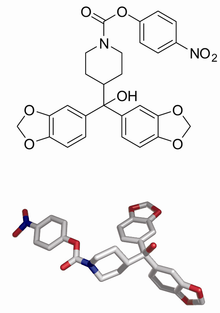
| |
| Names | |
|---|---|
| Preferred IUPAC name
4-Nitrophenyl 4-[di(2H-1,3-benzodioxol-5-yl)(hydroxy)methyl]piperidine-1-carboxylate | |
| Identifiers | |
3D model (JSmol)
|
|
| ChEBI | |
| ChEMBL | |
| ChemSpider | |
PubChem CID
|
|
| UNII | |
CompTox Dashboard (EPA)
|
|
| |
| |
| Properties | |
| C27H24N2O9 | |
| Molar mass | 520.15 g/mol |
| Appearance | Pale yellow solid |
Except where otherwise noted, data are given for materials in their standard state (at 25 °C [77 °F], 100 kPa).
| |
JZL184 is an irreversible inhibitor for monoacylglycerol lipase (MAGL), the primary enzyme responsible for degrading the endocannabinoid 2-arachidonoylglycerol (2-AG).[1] It displays high selectivity for MAGL over other brain serine hydrolases, including the anandamide-degrading enzyme fatty acid amide hydrolase (FAAH), thereby making it a useful tool for studying the effects of endogenous 2-AG signaling, in vivo. Administration of JZL184 to mice was reported to cause dramatic elevation of brain 2-AG leading to several cannabinoid-related behavioral effects.
See also[edit]
References[edit]
- ^ Long JZ, Li W, Booker L, Burston JJ, Kinsey SG, Schlosburg JE, Pavón FJ, Serrano AM, Selley DE, Parsons LH, Lichtman AH, Cravatt BF (November 2008). "Selective blockade of 2-arachidonoylglycerol hydrolysis produces cannabinoid behavioral effects". Nat. Chem. Biol. 5 (1): 37–44. doi:10.1038/nchembio.129. PMC 2605181. PMID 19029917.